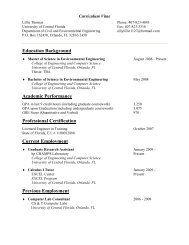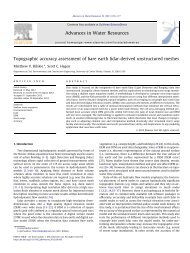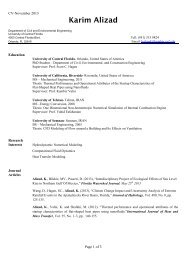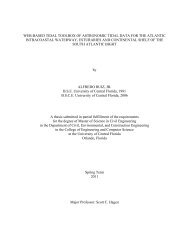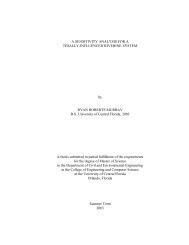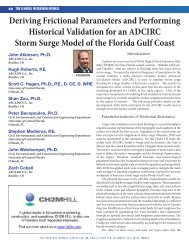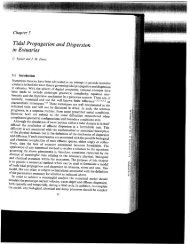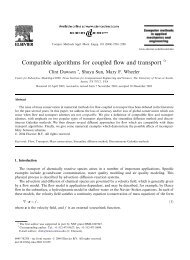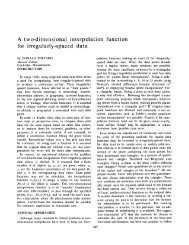Classical tidal harmonic analysis including error estimates in ...
Classical tidal harmonic analysis including error estimates in ...
Classical tidal harmonic analysis including error estimates in ...
Create successful ePaper yourself
Turn your PDF publications into a flip-book with our unique Google optimized e-Paper software.
932<br />
and is related to Eq. (2) by Ak ¼ ak þ a k and Bk ¼<br />
iðak a kÞ: The real representation is more convenient<br />
for the l<strong>in</strong>ear <strong>error</strong> <strong>analysis</strong> described later.<br />
Constituents can be chosen from a list of 45<br />
astronomical and 101 shallow-water constituents. Data<br />
structures conta<strong>in</strong><strong>in</strong>g names and other <strong>in</strong>formation<br />
about these constituents are loaded us<strong>in</strong>g t getconsts.<br />
There are several alternatives for select<strong>in</strong>g constituents.<br />
For general use, an automated selection algorithm<br />
(follow<strong>in</strong>g Foreman, 1977) is <strong>in</strong> place, which works as<br />
follows. A basis of all astronomical and 24 of the most<br />
important shallow-water constituents are gathered<br />
together. All constituents are listed <strong>in</strong> order of predef<strong>in</strong>ed<br />
importance based on equilibrium amplitudes.<br />
Less important constituents whose frequencies are less<br />
than a Rayleigh resolution limit aðNDtÞ 1 (with default<br />
a ¼ 1) apart from more important constituents <strong>in</strong><br />
frequency are discarded. Additional shallow-water constituents<br />
can be specified if required. If the relative<br />
phase/amplitude of two constituents that are otherwise<br />
unresolvable is known from other sources, then an<br />
<strong>in</strong>ference procedure can be carried out. Alternatively,<br />
constituent lists can be explicitly specified.<br />
The least-squares fit are the coefficients m<strong>in</strong>imiz<strong>in</strong>g<br />
E ¼ X<br />
jxðtmÞ yðtmÞj 2 ¼jjTa yjj 2 ; ð4Þ<br />
m<br />
where y ¼½yðt1Þ; yðt2Þ; y; yðtMÞŠ 0 ; a ¼½b0; b1; a1; a 1; a2;<br />
a 2; y; a NŠ 0 ; and T is an M 2N þ 2 matrix of l<strong>in</strong>ear<br />
and s<strong>in</strong>usoidal basis functions evaluated at observation<br />
times. The solution is found us<strong>in</strong>g the Matlab ‘‘W’’<br />
matrix division operator.<br />
Once the fit has been performed, various corrections<br />
are applied. These are generated <strong>in</strong> t vuf. First, the phase<br />
of the constituent response is usually reported as<br />
‘‘Greenwich phase’’ gk; that is, phase referenced to the<br />
phase of the equilibrium response at 01 longitude (the<br />
Greenwich meridian). This can be <strong>in</strong>terpreted as<br />
report<strong>in</strong>g the phase of the response at the time when<br />
the equilibrium forc<strong>in</strong>g is at its largest positive value at<br />
01 longitude. It is simplest to f<strong>in</strong>d the fitted phase at the<br />
central time of the record ðt ¼ 0Þ; the equilibrium phase<br />
vk is then just Va for the given constituent computed at<br />
the Julian date correspond<strong>in</strong>g to this central time, with<br />
possible adjustments of 1 1 3<br />
4 ; 2 ; or 4 cycle depend<strong>in</strong>g on<br />
whether A or B is non-zero, and their signs.<br />
Second, if a latitude is specified, then nodal or satellite<br />
corrections are computed as follows. Consider a ma<strong>in</strong><br />
peak of <strong>in</strong>dex k with satellites with <strong>in</strong>dices kj: The effect<br />
of the different satellites will be to slowly modulate the<br />
phase/amplitude of the ma<strong>in</strong> peak over various periods,<br />
usually more than 8 years. Our fitted response #ak over<br />
some period can then be written as a modification of the<br />
‘‘true’’ response of the ma<strong>in</strong> constituent ak; <strong>in</strong> which the<br />
amplitude is changed by a factor fk and the phase by an<br />
angle uk due to the presence of the satellites. fk and uk<br />
R. Pawlowicz et al. / Computers & Geosciences 28 (2002) 929–937<br />
are called the nodal correction amplitude and phase,<br />
respectively. That is,<br />
#ake iskt<br />
¼ fkake isktþiuk ¼ ake iskt<br />
X<br />
þ akje iskjt<br />
: ð5Þ<br />
Cancell<strong>in</strong>g common terms, we have<br />
fke iuk<br />
X akj<br />
¼ 1 þ<br />
j<br />
e<br />
ak<br />
iðskj<br />
X<br />
skÞt akj<br />
E1 þ<br />
ak j<br />
j<br />
: ð6Þ<br />
The f<strong>in</strong>al approximation will hold as long as ðskj skÞt<br />
rema<strong>in</strong>s ‘‘small’’ (i.e., Ndt58 years). In general the true<br />
phases and amplitudes of the satellites are not known.<br />
However, s<strong>in</strong>ce their frequencies are very similar to that<br />
of the ma<strong>in</strong> peak it is standard to assume the ratio of<br />
true amplitudes is the same as the ratio of amplitudes <strong>in</strong><br />
the equilibrium response, and the difference <strong>in</strong> true<br />
phases will be equal to the difference <strong>in</strong> equilibrium<br />
phases. The nodal corrections are thus computed from<br />
the equilibrium response Eq. (1). A latitud<strong>in</strong>al depen-<br />
dence arises from the geodetic functions. G 0 1<br />
is zero at<br />
the equator and a crude limit<strong>in</strong>g is used to prevent some<br />
diurnal corrections from gett<strong>in</strong>g overly large. The<br />
validity of us<strong>in</strong>g the latitude-dependent equilibrium<br />
response to predict an aspect of the dynamic behavior<br />
<strong>in</strong> one part of an ocean bas<strong>in</strong> <strong>in</strong> such a simple way is not<br />
clear. If the record length is longer than 1 year the<br />
comparison of successive 1 year analyses with and<br />
without nodal correction can be used to test the validity<br />
of this process. Note that if the time series to be analyzed<br />
is longer than 18.6 years <strong>in</strong> length then the ‘‘true’’<br />
satellite amplitude/phase terms can be estimated directly<br />
(Foreman and Neufeld, 1991) but this is not currently<br />
possible <strong>in</strong> T TIDE.<br />
The products of the <strong>analysis</strong> above are a pair of<br />
complex values fak; a kg; possibly corrected for nodal<br />
modulation, for each constituent k: These are converted<br />
<strong>in</strong>to standard parameters:<br />
Lk ¼jakjþja kj; ð7Þ<br />
lk ¼jakj ja kj; ð8Þ<br />
yk ¼ angðakÞþangða kÞ<br />
mod 180; ð9Þ<br />
2<br />
gk ¼ vk angðakÞþyk: ð10Þ<br />
For horizontal currents, these parameters describe the<br />
features of an ellipse traced out by the tip of the velocity<br />
vector: the length of the semi-major and semi-m<strong>in</strong>or axis<br />
of the ellipse (Lk; lk; respectively), the <strong>in</strong>cl<strong>in</strong>ation of the<br />
northern semi-major axis counter-clockwise from due<br />
east yk; and the Greenwich phase gk: If lk > 0 ðo0Þ then<br />
the ellipse is traced <strong>in</strong> a counter-clockwise (clockwise)<br />
direction. For scalar time series, the parameter Lk is the<br />
amplitude, and lk; yk 0 (the ellipse degenerates to a<br />
l<strong>in</strong>e along the positive axis). Note that the restriction of<br />
the def<strong>in</strong>ition of <strong>in</strong>cl<strong>in</strong>ation to the northern axis (via the



